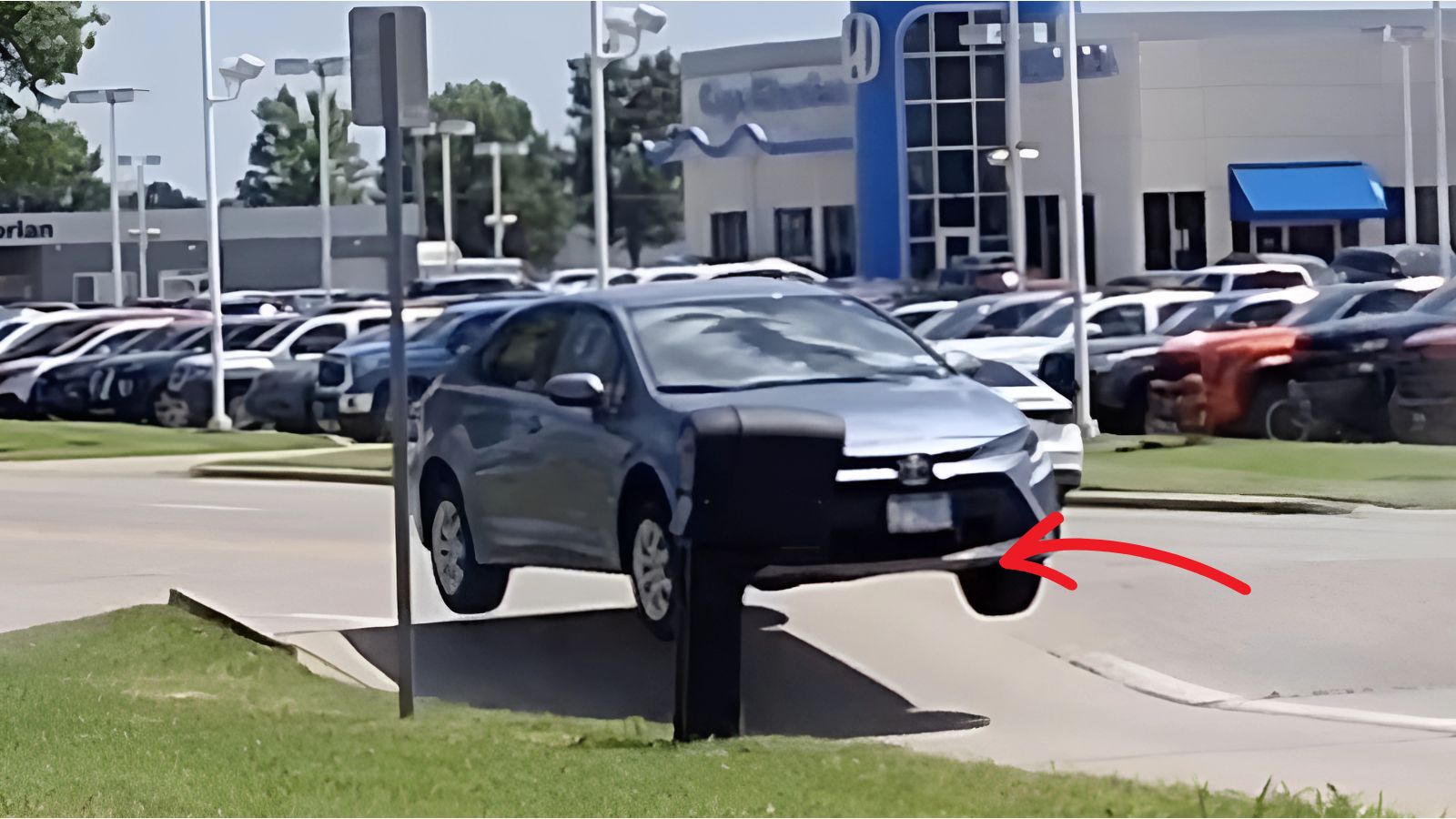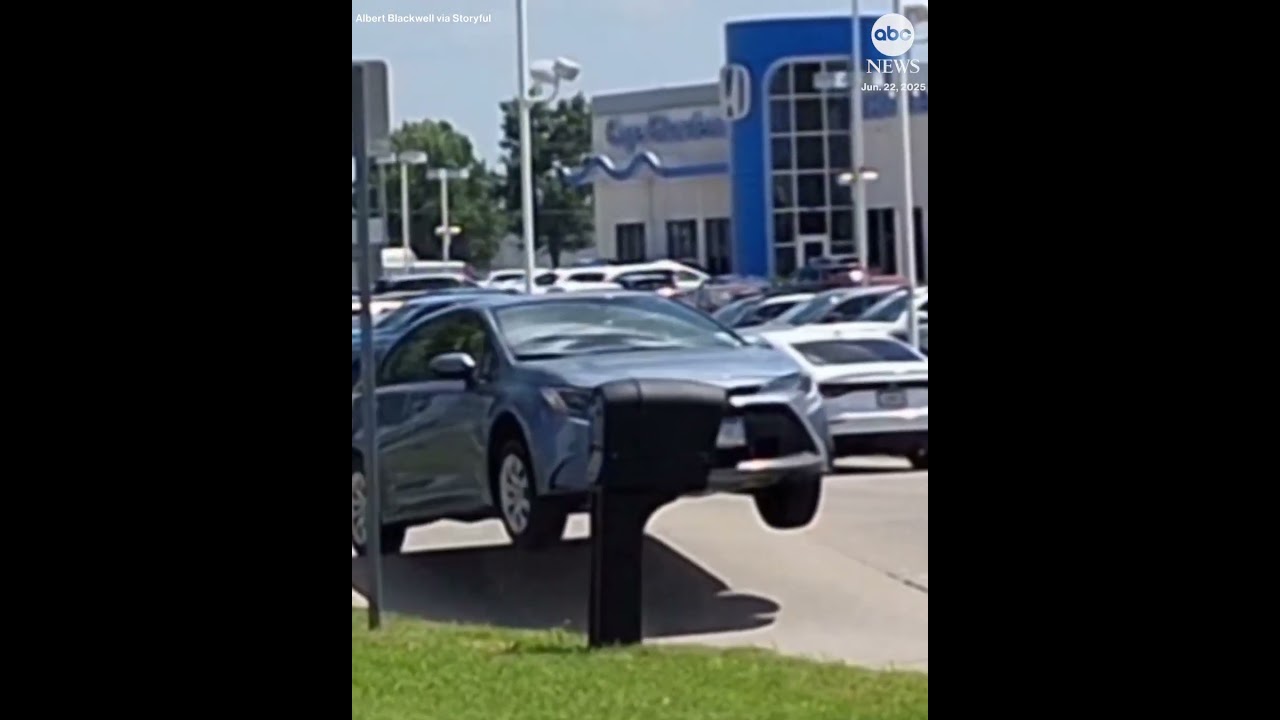The summer of 2025 has already proven to be one of extremes, with heat waves scorching regions unaccustomed to such temperatures. But while most people worry about air conditioning bills and staying hydrated, few consider how these unprecedented temperatures affect the very roads we drive on daily. That changed dramatically this week in Cape Girardeau, Missouri, where a Toyota Corolla driver got an unexpected lesson in physics when their routine drive suddenly turned into an impromptu airborne adventure.
The Incident That Shocked Missouri
In what can only be described as a scene straight out of an action movie, surveillance footage captured the moment a section of roadway in Cape Girardeau spontaneously buckled under extreme heat, creating an instant ramp that launched an unsuspecting Toyota Corolla into the air. The driver, going about their normal day, had absolutely no time to react as the pavement beneath them literally transformed in real-time.
The dramatic video shows the road suddenly popping upward with enough force to launch a nearby traffic cone skyward, narrowly missing a passing Honda Accord. Moments later, the Toyota Corolla approaches the newly formed “jump,” and physics takes over. The compact sedan sails through the air before landing hard on its nose, bouncing violently as the driver likely wondered if they’d accidentally entered some alternate reality where roads double as skateboard ramps.
The Science Behind Heat-Related Road Failure
While winter potholes grab headlines every spring, the damage caused by extreme heat often flies under the radar until dramatic incidents like this occur. Asphalt and concrete expand when heated, and during prolonged heat waves, this expansion can exceed the road’s design tolerances. When roads have nowhere to expand horizontally due to curbs, barriers, or adjacent structures, the only direction left is up.
The buckling process typically begins with small cracks that allow sections of pavement to move independently. As temperatures soar, these sections push against each other with tremendous force. Eventually, something has to give, and that “something” is usually a sudden, violent upward displacement of the road surface.
Engineers design roadways with expansion joints to accommodate thermal movement, but these systems can be overwhelmed during unprecedented heat events. When temperatures climb well beyond historical norms, even well-designed infrastructure can fail catastrophically.
The Growing Threat to American Infrastructure
This Missouri incident represents more than just a freak occurrence—it’s a preview of challenges facing transportation infrastructure nationwide as climate patterns shift. The American Society of Civil Engineers has long warned about the vulnerability of aging road systems, but extreme weather events are accelerating deterioration timelines and creating entirely new failure modes.
Roads built decades ago weren’t designed for the temperature extremes now becoming commonplace. Materials and construction techniques that worked fine for historical climate patterns are being stressed beyond their limits. The result is an increasing frequency of unexpected failures that pose serious safety risks to motorists.
Beyond dramatic buckling events, heat-related road damage manifests in numerous ways. Asphalt becomes soft and malleable, leading to rutting and deformation under traffic loads. Concrete joints can fail, creating dangerous height differences between pavement sections. Even painted lane markings can deteriorate rapidly, reducing visibility and safety.
What Drivers Need to Know
For everyday drivers, incidents like the Missouri buckling serve as important reminders about road safety during extreme weather. While predicting exactly when and where a road might fail is nearly impossible, there are warning signs motorists should watch for.
Fresh cracks appearing in roadways, especially those running perpendicular to traffic flow, can indicate thermal stress building in the pavement. Areas where the road surface appears raised or uneven, even slightly, deserve extra caution. Strange popping or cracking sounds from the pavement, though rare, could signal imminent failure.
During heat waves, consider adjusting your driving habits. Reduced speeds give you more time to react to unexpected road conditions. Increased following distances provide additional safety margins. Most importantly, stay alert and avoid distractions—road conditions can change literally in seconds, as the Missouri driver learned firsthand.
The Economic Impact of Climate-Related Infrastructure Damage
The financial implications of heat-related road damage extend far beyond individual repair costs. Emergency road closures disrupt commerce and commuting, costing communities millions in lost productivity. Emergency repairs are significantly more expensive than planned maintenance, straining already tight municipal budgets.
Insurance implications are equally concerning. As extreme weather events become more frequent, coverage for infrastructure damage may become more expensive or restrictive. Property owners adjacent to failed roads can face liability issues, while businesses depending on affected routes suffer economic losses.
The broader economic message is clear: investing in climate-resilient infrastructure today costs far less than dealing with catastrophic failures tomorrow. Unfortunately, political and budget realities often prevent the proactive investments needed to address these growing challenges.
Engineering Solutions for a Hotter Future
The engineering community is responding to climate challenges with innovative solutions designed for tomorrow’s temperature extremes. Advanced materials resist thermal expansion better than traditional asphalt and concrete. Improved expansion joint designs accommodate greater thermal movement. Some experimental roadways even incorporate cooling systems to reduce surface temperatures.
Smart monitoring systems can detect early signs of thermal stress, potentially providing warnings before catastrophic failures occur. Real-time temperature monitoring combined with predictive modeling could identify high-risk road sections during heat waves, allowing for preemptive closures or emergency repairs.
However, implementing these solutions requires significant investment and political will. Retrofitting existing infrastructure is expensive and disruptive, while building new roads to climate-resilient standards adds substantial upfront costs.
Lessons from Missouri’s Flying Toyota
The Toyota Corolla that went airborne in Missouri serves as an unintentional crash test for infrastructure resilience. While the immediate focus is on the dramatic spectacle, the incident highlights several crucial points about modern transportation challenges.
First, infrastructure failures can happen anywhere, anytime, during extreme weather events. Traditional maintenance schedules and inspection protocols may be inadequate for rapidly changing climate conditions. Emergency response plans must account for sudden, unprecedented failures that can’t be predicted using historical data.
Second, the human factor remains critical. Even the best engineering solutions are only as good as the systems supporting them. Public awareness, proper maintenance funding, and political commitment to infrastructure investment all play crucial roles in preventing future incidents.
The Road Ahead
As climate change continues to reshape weather patterns, incidents like Missouri’s road buckling will likely become more common rather than less. The choice facing communities nationwide is whether to address these challenges proactively through strategic infrastructure investment or reactively through emergency repairs after dramatic failures.
The Toyota Corolla driver in Missouri got lucky—their unexpected flight ended without serious injury. However, the next driver facing a suddenly transformed roadway might not be so fortunate. The incident serves as a wake-up call about the hidden vulnerabilities in infrastructure we take for granted every day.
Moving forward, resilience must become a central consideration in transportation planning. This means not just fixing what’s broken, but reimagining how roads should be built for a climate that’s already changing faster than many anticipated. The alternative is more surprised drivers finding themselves unexpectedly airborne when their morning commute turns into an unplanned physics experiment.
The road ahead—literally and figuratively—requires acknowledging that yesterday’s infrastructure solutions may not meet tomorrow’s challenges. Missouri’s flying Toyota is just the beginning of a conversation that needs to happen in every community across America.

